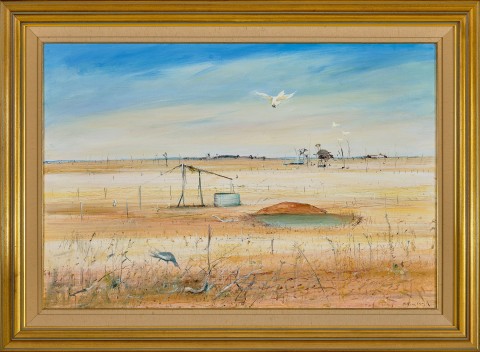WIMMERA, c.1972
ARTHUR BOYD
oil on canvas
57.5 x 85.5 cm
signed lower right: Arthur Boyd
Ian Gawler, Melbourne
Private collection, Melbourne, acquired from the above in 1976
From his earliest impressionist views of the Mornington Peninsula outside Melbourne to the masterly depictions of his beloved Shoalhaven River, Arthur Boyd demonstrated a continuing fascination with the Australian landscape. His eye was drawn to the nuances and ever-changing vagaries of nature, from the primordial tangle of the Australian bush to the various ways humanity had intervened with farming and mining. This preoccupation continued overseas at his English and Italian residences and where ‘(i)n a snow-bound studio he… envisioned the desert: in a garden of ash and maple trees, he … painted gum and wattle.’1 Wimmera, c.1972 is an evocative example of this aspect of Boyd’s expatriate’s vision, for ‘the Australian landscape, strongly held in memory, was as accessible to him in his Suffolk Studio as anywhere else.’2
Boyd first visited the Wimmera in Victoria’s heat-shimmered north-west in the summer of 1948 – 49, painting at the border of the Wimmera River. Many of the landscapes from this period are recognised masterworks by the artist and he continued to paint variations at different times in his life. These were not copies of or even homages to the earlier works; rather, each was a return by the artist to a treasured memory seeking to re-depict it in a manner more closely aligned to his current psychological state of mind, creating a painterly oasis for calm reflection. During the 1970s, Boyd exhibited extensively in London and Australia, and following a visit to one such show at Fischer Fine Art, his younger colleague Brett Whiteley wrote to Boyd that ‘it really is remarkable and masterly of you to be able to hold that dry white heat of the bush in your head from 12,000 miles… So really congratulations on the feeling of pale intense beauty you have pulled out of the Australian bush, it’s such a great subject.’3
In Wimmera, c.1972, a rudimentary rain gutter provides water to a water tank which in turn feeds a small dam, the edges of which have been eroded by sheep’s hooves. The foreground is a close scattering of spiky native grasses and wheat, a semi-permeable barrier to the scene beyond. Wide verandahs encircle the distant homestead, though its galvanised tin roof receives little relief from the sun due to the complete deforestation of the home paddock. It feels insular, cut off from the outside world, a somnambulist scene which (in real life) would have been rent by the sound of screeching cockatoos. Birds always inhabit Boyd’s Wimmera paintings, others of which include crows and eagles, or in this case, a heron searching among the stalks for stray seeds and insects. Most likely painted at his Suffolk studio, Wimmera, c.1972, remains an inviting and nostalgic elegy to a cherished land by a revered Australian artist many thousands of miles from his home.
1. McGrath, S., ‘Boyd still the master’, The Australian, Sydney, 12 March 1980
2. Niall, B., The Boyds, Melbourne University Press, Victoria, 2007, p. 342
3. Brett Whiteley, cited in Bungey, D, Arthur Boyd: a life, Allen and Unwin, Sydney, 2007, p. 497
ANDREW GAYNOR


